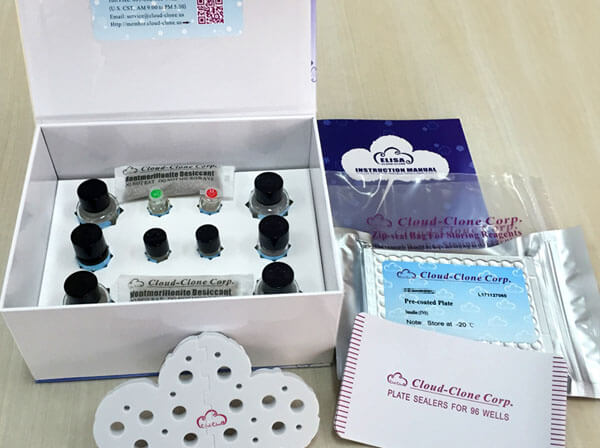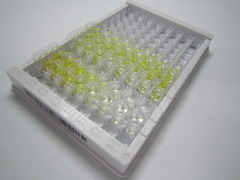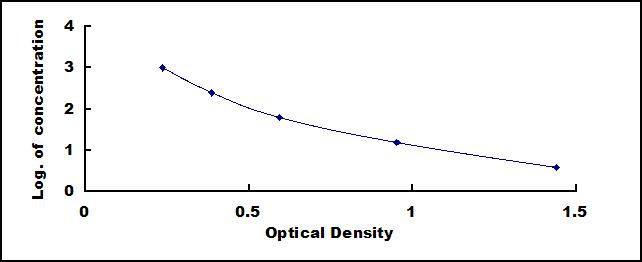ELISA Kit for Triglyceride (TG) 

TAG; Triacylglycerol; Triacylglyceride
- UOM
- FOB US$ 565.00 US$ 808.00 US$ 3,634.00 US$ 6,864.00 US$ 56,525.00
- Quantity
Overview
Properties
- Product No.CEB687Ge
- Organism SpeciesPan-species (General) Same name, Different species.
- ApplicationsEnzyme-linked immunosorbent assay for Antigen Detection.
Research use only - DownloadInstruction Manual
- CategoryMetabolic pathwayCardiovascular biologyHepatologyNutrition metabolism
Sign into your account
Share a new citation as an author
Upload your experimental result
Review

Contact us
Please fill in the blank.
Recovery
Matrices listed below were spiked with certain level of recombinant Triglyceride (TG) and the recovery rates were calculated by comparing the measured value to the expected amount of Triglyceride (TG) in samples.
| Matrix | Recovery range (%) | Average(%) |
| serum(n=5) | 83-97 | 91 |
| EDTA plasma(n=5) | 94-105 | 101 |
| heparin plasma(n=5) | 78-93 | 88 |
Precision
Intra-assay Precision (Precision within an assay): 3 samples with low, middle and high level Triglyceride (TG) were tested 20 times on one plate, respectively.
Inter-assay Precision (Precision between assays): 3 samples with low, middle and high level Triglyceride (TG) were tested on 3 different plates, 8 replicates in each plate.
CV(%) = SD/meanX100
Intra-Assay: CV<10%
Inter-Assay: CV<12%
Linearity
The linearity of the kit was assayed by testing samples spiked with appropriate concentration of Triglyceride (TG) and their serial dilutions. The results were demonstrated by the percentage of calculated concentration to the expected.
| Sample | 1:2 | 1:4 | 1:8 | 1:16 |
| serum(n=5) | 82-96% | 98-105% | 89-97% | 90-99% |
| EDTA plasma(n=5) | 91-104% | 78-102% | 80-91% | 96-103% |
| heparin plasma(n=5) | 86-101% | 93-101% | 96-105% | 92-101% |
Stability
The stability of kit is determined by the loss rate of activity. The loss rate of this kit is less than 5% within the expiration date under appropriate storage condition.
To minimize extra influence on the performance, operation procedures and lab conditions, especially room temperature, air humidity, incubator temperature should be strictly controlled. It is also strongly suggested that the whole assay is performed by the same operator from the beginning to the end.
Reagents and materials provided
| Reagents | Quantity | Reagents | Quantity |
| Pre-coated, ready to use 96-well strip plate | 1 | Plate sealer for 96 wells | 4 |
| Standard | 2 | Standard Diluent | 1×20mL |
| Detection Reagent A | 1×120µL | Assay Diluent A | 1×12mL |
| Detection Reagent B | 1×120µL | Assay Diluent B | 1×12mL |
| TMB Substrate | 1×9mL | Stop Solution | 1×6mL |
| Wash Buffer (30 × concentrate) | 1×20mL | Instruction manual | 1 |
Assay procedure summary
1. Prepare all reagents, samples and standards;
2. Add 50µL standard or sample to each well.
And then add 50µL prepared Detection Reagent A immediately.
Shake and mix. Incubate 1 hour at 37°C;
3. Aspirate and wash 3 times;
4. Add 100µL prepared Detection Reagent B. Incubate 30 minutes at 37°C;
5. Aspirate and wash 5 times;
6. Add 90µL Substrate Solution. Incubate 10-20 minutes at 37°C;
7. Add 50µL Stop Solution. Read at 450 nm immediately.

Test principle
This assay employs the competitive inhibition enzyme immunoassay technique. A monoclonal antibody specific to Triglyceride (TG) has been pre-coated onto a microplate. A competitive inhibition reaction is launched between biotin labeled Triglyceride (TG) and unlabeled Triglyceride (TG) (Standards or samples) with the pre-coated antibody specific to Triglyceride (TG). After incubation the unbound conjugate is washed off. Next, avidin conjugated to Horseradish Peroxidase (HRP) is added to each microplate well and incubated. The amount of bound HRP conjugate is reverse proportional to the concentration of Triglyceride (TG) in the sample. After addition of the substrate solution, the intensity of color developed is reverse proportional to the concentration of Triglyceride (TG) in the sample.
Giveaways
Increment services
Citations
- Adiponectin protects the rats liver against chronic intermittent hypoxia induced injury throughAMP-activated protein kinase pathway.pubmed:27678302
- Insulin restores UCP3 activity and decreases energy surfeit to alleviate lipotoxicity in skeletal musclepubmed:29039450
- Proteomic approaches in the discovery of potential urinary biomarkers of mucopolysaccharidosis type IIPubmed: 31469979
- Regulation and Mechanism of miR-518d through the PPARα-Mediated NF-κB Pathway in the Development of Gestational Diabetes MellitusPubmed: 33123597
- Gut Dysbiosis Contribute to High Fructose Induced Salt Sensitive Hypertension In Sprague-Dawley Rats
- Immune responses against oxidized LDL as possible targets for prevention of atherosclerosis in systemic lupus erythematosus33857652
- GP73 is a TBC-domain Rab GTPase-activating protein contributing to the pathogenesis of non-alcoholic fatty liver disease without obesity34853313











